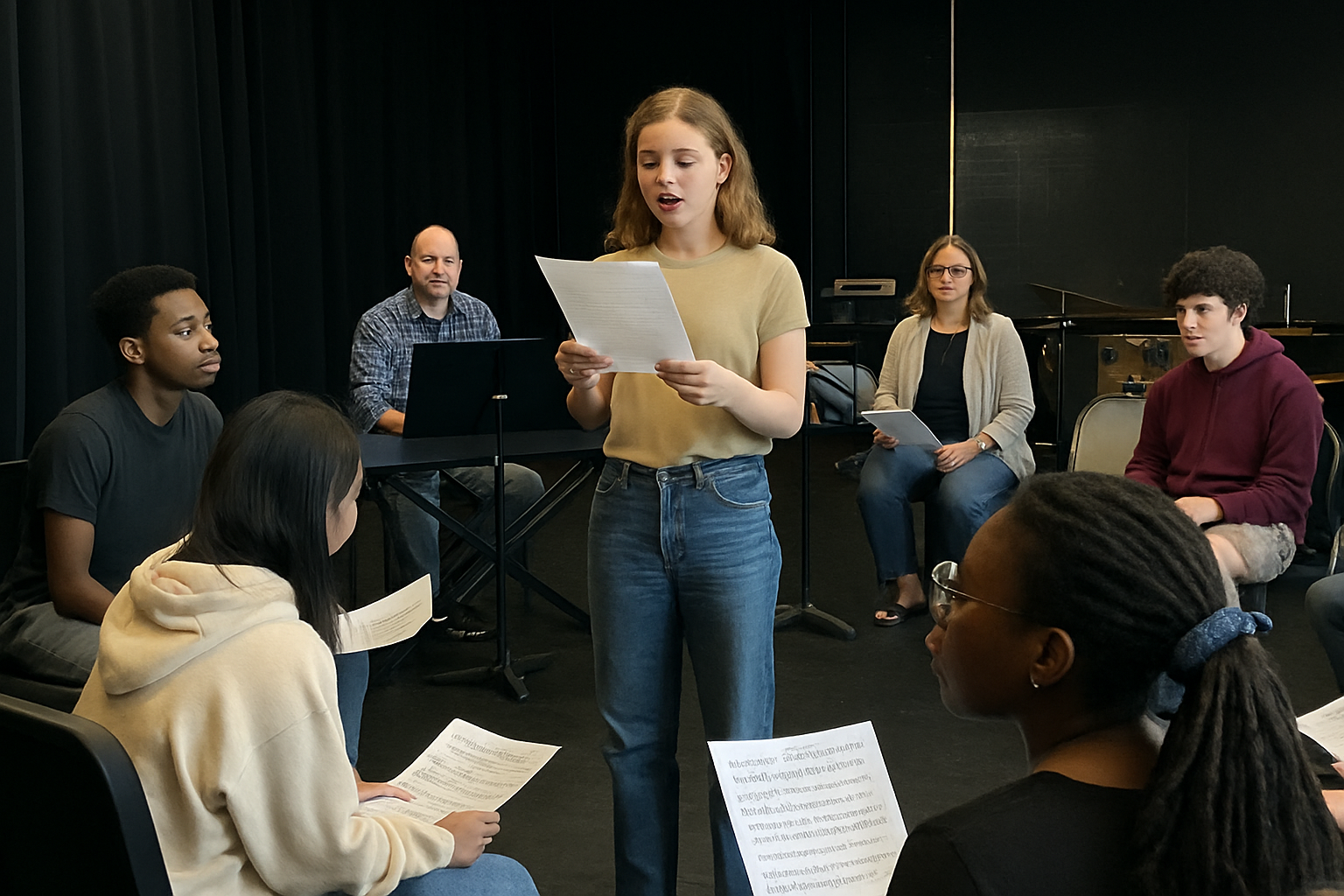5 Essential Tips for Educators: Incorporating Musical Theatre into Your Curriculum
By Broadwaytrax Content Studio · September 28, 2025
Updated September 28, 2025
On a gray Monday during Fall 2025 tech week, a ninth grader stepped to the front of the choir room-turned-black-box and offered a line reading that wasn’t perfect but was brave. The class applauded without prompting. That moment—half rehearsal, half breakthrough—is why musical theatre belongs in the curriculum. It’s not just about the show; it’s about building musicianship, literacy, collaboration, and voice.
Tip 1: Start with Standards and Backwards Design
Begin by mapping musical theatre units to Create, Perform, Respond, and Connect, the backbone of the National Core Arts Standards for music and theatre. When you plan with the end in mind (a juried performance, a scene-and-song showcase, or a recorded portfolio), it becomes easier to craft daily tasks that lead there: lyric annotation for Respond, 16-bar cut prep for Perform, character journals for Connect, and a devised opening number for Create. Align rubrics to observable indicators such as intonation, diction, character intention, and ensemble awareness so that students know how learning will be measured ((National Core Arts Standards); (Educational Theatre Association)).
Tip 2: Choose Repertoire that Fits Voices, Identities, and Goals
The right song unlocks both confidence and technique. For younger singers, look for age-appropriate pieces with moderate ranges, conversational text, and clear storytelling; Broadway Junior adaptations can be a starting point for ensembles exploring style without punishing tessitura (Music Theatre International). For changing voices, prioritize keys that sit comfortably in speech-mix and allow students to discover resonance without strain. A pre-unit vocal check helps you match students to the material and spot where a transposition is prudent. Build in time to compare versions in different keys and discuss how key affects character energy, tempo, and phrasing.
This is where technology supports inclusion. A licensed accompaniment track library, ideally with multiple keys, rehearsal cuts, and tempos, streamlines differentiation and home practice. It also supports student choice by removing the barrier of ‘we only have the music in that one key.’ When repertoire invites cultural connections and lived experiences, engagement climbs. Culturally responsive selection is not about tokenizing; it’s about offering mirrors and windows so every student sees themselves and explores others with respect. Universal Design for Learning principles can guide flexible materials (text, audio, visuals) and multiple ways to demonstrate learning (CAST UDL Guidelines).
Tip 3: Teach Theatre as Literacy and Musicianship
Treat a song like a scene with a score. Before you sing, read the lyric as a monologue. Identify objective, tactics, and obstacles. Mark phrasing, caesuras, and internal rhymes that cue breath and thought. Scan tricky rhythms by speaking on an ‘8-count’ and then on neutral syllables to bridge speech to singing. Invite students to annotate subtext, then test choices on their feet with simple blocking so musical phrasing serves storytelling, not the other way around.
For deeper integration, frame mini-projects through arts integration and project-based learning: program notes that cite textual evidence, composer/lyricist research that traces motif and theme, or a small group staging lab that justifies choices in a director’s note. Performance becomes evidence of understanding, not just a culminating event ((Kennedy Center); (Edutopia)).

Tip 4: Build Rehearsal Habits that Protect Voices and Spark Imagination
Anchor every class with a concise warmup that crosses the actor–singer line: breath and SOVT straws for efficiency, gentle sirens through speech-mix, articulation drills on text from your repertoire, followed by a quick physical sequence to free posture. Normalize ‘vocal green flags’ (easy onset, clear resonance, comfortable range) and ‘yellow flags’ (fatigue after class, persistent throatiness) so students learn to self-advocate. Reinforce that healthy belting is about alignment, breath, and acoustics—not pushing. When in doubt, modify keys or redistribute lines rather than chase volume (NATS).
Layer in drama-based strategies to keep the room imaginative: tableaux to stage a musical’s turning point before singing it, hot seating to explore character backstory, and status walks to experiment with physical choices that later inform phrasing. Rotating micro-rehearsal stations including text, music, movement, and reflection allows you to coach in small bursts while peers practice independently with tracks and clear prompts (UT Austin Drama-Based Instruction).
Tip 5: Assess Process and Product
Musical theatre yields rich artifacts if you collect them. A performance rubric might track intonation, diction, phrasing, dramatic intention, and collaboration, but pair it with reflective tools: a video journal for weekly goals, a self-assessment after the first run, and a peer note exchange that references rubric language. Consider portfolio checkpoints tied to the standards: a marked score with breath plans (Perform), a written reflection on a character choice (Connect), a short devised duet or parody lyric (Create), and a lyric annotation citing textual evidence (Respond). Model Cornerstone Assessments from the standards community can inspire task design and criteria ((National Core Arts Standards); (Educational Theatre Association)).
A quick legal note: when concerts include songs from shows, ensure you have appropriate rights for performance, recordings, and streams. Classroom study of excerpts is typically fair use, but public performance and distribution are not. Check with your district and the licensing house for clarity and your future self will thank you (Music Theatre International).
Putting it together this Fall 2025 might look like a six-week unit that culminates in a scene-and-song showcase. Students select from a curated list spanning eras and styles, each available in two or three keys to meet voices where they are. Rehearsals lean on structured rituals, short stations, and intentional literacy tasks. Assessments document growth from the first read to the final bow. The room hums with accompaniment tracks in headphones, whispered monologues, and the quiet confidence of students who know what they’re aiming for and how to get there.
The applause at the end is wonderful. What lingers longer is the transfer: clearer diction in choir, stronger analysis in English, braver choices in life. That’s a curriculum worth staging.